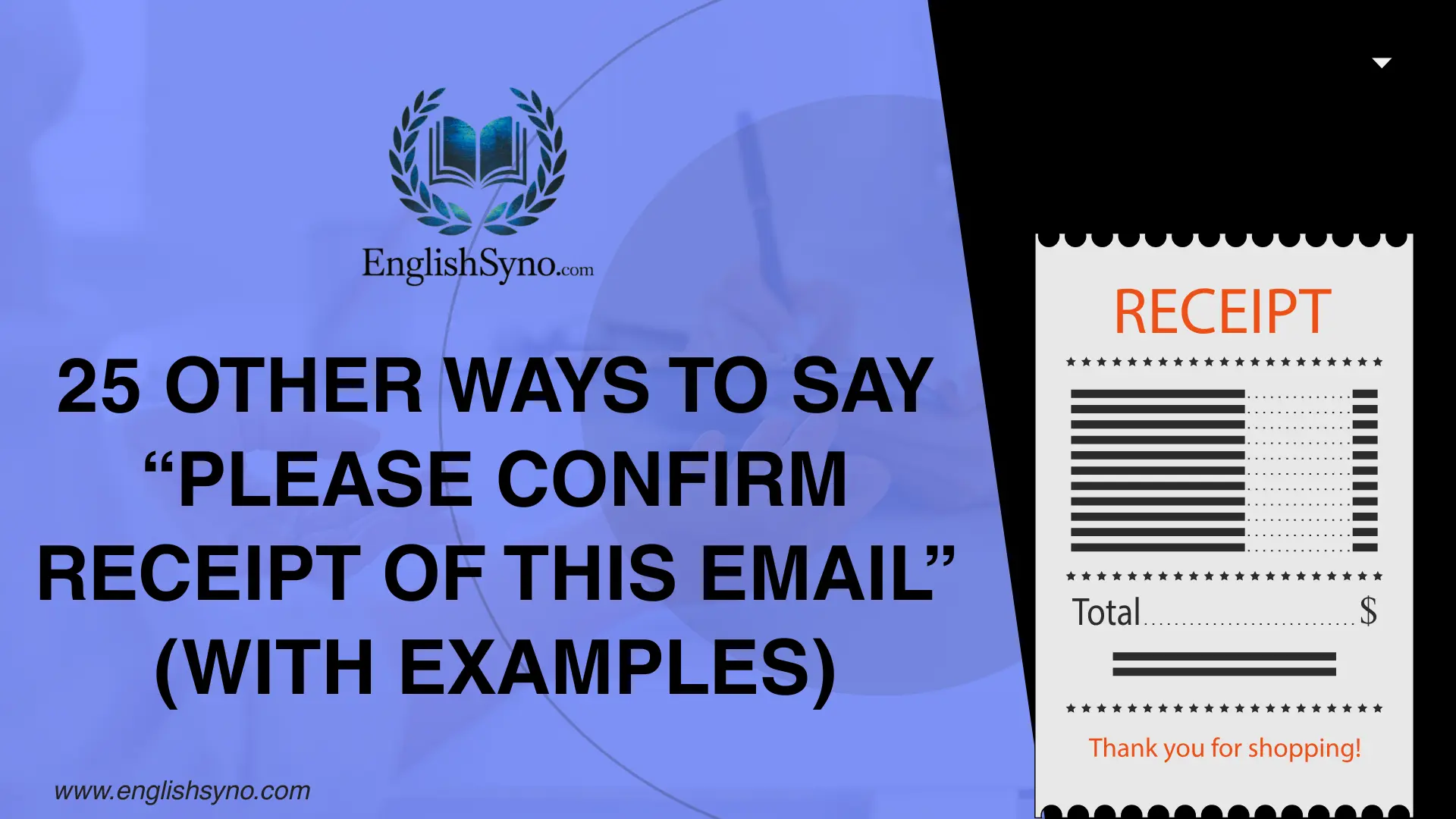When you send an email and want to make sure it was received, it’s always good to ask the recipient to please confirm receipt of this email, a simple reply like “Thank you, I have received this email” keeps professional communication polite, standard, and sufficient, ensuring the message wasn’t missed, lost, or accidentally sent to spam, and helps save confusion on important tasks, attachments, or information.
There are ten alternatives to phrase this request, fitting a different tone or situation. You might choose a formal approach for professional emails, or a more informal touch when asking someone familiar. Each phrase is suitable to use, and may contain key acknowledgment actions, focusing on clarity so the sender knows the message wasn’t lost. It’s particularly useful to adapt your own style, ensuring your communication remains polite and effective.
What Does “please confirm receipt of this email” Mean?
The phrase “please confirm receipt of this email” is a polite request asking the recipient to acknowledge that they have received the message. It ensures that the sender knows the email was delivered and read, especially for important tasks, attachments, or information.
When to Use “please confirm receipt of this email”
Use this phrase when you need confirmation for critical emails, documents, or tasks that require acknowledgment. It’s especially important when waiting for a reply or when timeliness matters.
Is It Professional/Polite to say “please confirm receipt of this email”?
Yes, it is considered professional and polite in most work contexts. It conveys that you are respectful of the recipient’s time while ensuring clarity in communication.
Pros or Cons
Pros: Ensures acknowledgment, maintains clarity, reduces missed emails, and sets a formal tone
Cons: Can feel repetitive if overused, may come across as overly formal in casual communication
Kindly acknowledge receipt
Definition & Meaning: Asking the recipient to confirm they have politely received the email.
Detailed Explanation: This phrasing softens the request, making it more courteous.
Example Email:
Hi [Recipient],
I hope you’re doing well. Could you kindly acknowledge receipt of this email at your earliest convenience?
Thank you,
[Your Name]
Best Use: Formal communications, sensitive information
Worst Use: Overly casual chats
Tone: Polite, professional, courteous
Please let me know once received
Definition & Meaning: A friendly request for the recipient to confirm that the message reached them.
Detailed Explanation: Adds a personal touch while remaining professional.
Example Email:
Dear [Recipient],
Please let me know once this email is received. Your confirmation would be greatly appreciated.
Regards,
[Your Name]
Best Use: Emails with attachments or time-sensitive requests
Worst Use: Redundant in long email threads
Tone: Friendly, professional
Confirm you have received this email
Definition & Meaning: Directly asks for acknowledgment that the email was received.
Detailed Explanation: Short, precise, and clear; less formal than other alternatives.
Example Email:
Hi [Recipient],
Could you confirm you have received this email?
Thanks,
[Your Name]
Best Use: Urgent emails, short professional messages
Worst Use: Can sound abrupt if tone is not softened
Tone: Direct, professional
Just checking if you received this
Definition & Meaning: Casual approach to ensure the email was received.
Detailed Explanation: Makes the recipient feel less pressured than formal phrasing.
Example Email:
Hello [Recipient],
Just checking if you received my previous email regarding [topic].
Best,
[Your Name]
Best Use: Informal professional emails, follow-ups
Worst Use: Very formal settings
Tone: Casual, polite
Kindly confirm you received this
Definition & Meaning: A courteous request asking the recipient to confirm receipt of the email.
Detailed Explanation: The word “kindly” softens the request, showing politeness and respect.
Example Email:
Dear [Recipient],
Could you kindly confirm you received this email?
Thank you,
[Your Name]
Best Use: Formal professional emails, sensitive information
Worst Use: Too formal for casual notes
Tone: Polite, respectful
Please acknowledge receipt
Definition & Meaning: A straightforward, polite request for acknowledgment.
Detailed Explanation: Direct and professional, widely used in business communications.
Example Email:
Hi [Recipient],
Please acknowledge receipt of this email at your earliest convenience.
Regards,
[Your Name]
Best Use: Formal letters, official documents
Worst Use: Informal chats or personal emails
Tone: Professional, formal
I would appreciate your confirmation
Definition & Meaning: Polite way to ask the recipient to confirm receipt of the message.
Detailed Explanation: Adds a personal touch and shows appreciation for their response.
Example Email:
Hello [Recipient],
I would appreciate your confirmation that you received this email.
Best regards,
[Your Name]
Best Use: Important tasks or attachments
Worst Use: Repetitive if used too frequently
Tone: Courteous, professional
Just confirming receipt
Definition & Meaning: Brief, polite way to ensure the email was received.
Detailed Explanation: Works well for short emails or follow-ups.
Example Email:
Hi [Recipient],
Just confirming receipt of my previous email.
Thanks,
[Your Name]
Best Use: Quick follow-ups
Worst Use: May feel abrupt if tone is not softened
Tone: Direct, polite
Could you confirm this message?
Definition & Meaning: Polite request asking the recipient to confirm the email was received.
Detailed Explanation: Slightly more casual and conversational than formal phrases.
Example Email:
Dear [Recipient],
Could you confirm this message at your earliest convenience?
Thanks,
[Your Name]
Best Use: Business emails, project updates
Worst Use: Overly casual in highly formal contexts
Tone: Polite, semi-formal
Please let me know if this reached you
Definition & Meaning: Asking the recipient to verify receipt in a friendly, polite manner.
Detailed Explanation: Adds a softer, personal tone while maintaining professionalism.
Example Email:
Hello [Recipient],
Please let me know if this email reached you safely.
Regards,
[Your Name]
Best Use: Informal professional emails, attachments
Worst Use: Not suitable for very formal legal letters
Tone: Friendly, professional
Confirm receipt at your convenience
Definition & Meaning: A Professional, polite request to confirm receipt.
Detailed Explanation: Shows flexibility, allowing the recipient to respond when convenient.
Example Email:
Hi [Recipient],
Could you confirm receipt at your convenience?
Thanks,
[Your Name]
Best Use: Non-urgent emails
Worst Use: Urgent or time-sensitive communications
Tone: Polite, professional
Would you mind confirming receipt?
Definition & Meaning: Polite and indirect request asking the recipient to acknowledge the email.
Detailed Explanation: Very courteous, avoids sounding demanding.
Example Email:
Dear [Recipient],
Would you mind confirming receipt of this email?
Best,
[Your Name]
Best Use: Sensitive or polite professional emails
Worst Use: Too long for quick internal emails
Tone: Respectful, courteous
Just a quick confirmation needed
Definition & Meaning: A Casual and concise way to request acknowledgment of email receipt.
Detailed Explanation: Keeps the message brief but polite, suitable for internal emails.
Example Email:
Hi [Recipient],
Just a quick confirmation is needed that you received this email.
Thanks,
[Your Name]
Best Use: Quick internal follow-ups
Worst Use: Formal client emails
Tone: Casual, polite
Could you acknowledge this email?
Definition & Meaning: Standard professional request for acknowledgment.
Detailed Explanation: Clear and direct, works well for business communication.
Example Email:
Hello [Recipient],
Could you acknowledge this email?
Regards,
[Your Name]
Best Use: Professional work emails
Worst Use: Overly brief for important emails
Tone: Direct, polite
Please verify receipt
Definition & Meaning: A Polite request to check and confirm the email was received.
Detailed Explanation: Suitable for important emails where confirmation is needed.
Example Email:
Hi [Recipient],
Please verify receipt of this email.
Thanks,
[Your Name]
Best Use: Formal emails, attachments
Worst Use: Too formal for casual messages
Tone: Professional, formal
Let me know you got this
Definition & Meaning: A Friendly and casual way to ask for acknowledgment.
Detailed Explanation: Less formal, adds a conversational tone.
Example Email:
Hey [Recipient],
Let me know you got this email when convenient.
Cheers,
[Your Name]
Best Use: Internal emails or familiar contacts
Worst Use: Very formal professional emails
Tone: Casual, polite
Please confirm this email
Definition & Meaning: A Direct and clear request for acknowledgment.
Detailed Explanation: Simple and widely used in professional communication.
Example Email:
Hi [Recipient],
Could you please confirm this email?
Best regards,
[Your Name]
Best Use: Standard professional emails
Worst Use: Overused in informal chats
Tone: Polite, professional
Acknowledge when convenient
Definition & Meaning: A Professional, polite request that allows the recipient to respond at leisure.
Detailed Explanation: Shows consideration for the recipient’s time.
Example Email:
Dear [Recipient],
Please acknowledge when convenient.
Thanks,
[Your Name]
Best Use: Non-urgent emails
Worst Use: Urgent communications
Tone: Polite, considerate
Could you let me know you received this?
Definition & Meaning: Polite, slightly more conversational request for confirmation.
Detailed Explanation: Maintains clarity without sounding too formal.
Example Email:
Hello [Recipient],
Could you let me know you received this email?
Regards,
[Your Name]
Best Use: Informal professional emails
Worst Use: Very formal client emails
Tone: Friendly, professional
Kindly confirm delivery
Definition & Meaning: Polite, professional way to confirm email delivery.
Detailed Explanation: Slightly more formal than general acknowledgment phrases.
Example Email:
Hi [Recipient],
Could you kindly confirm the delivery of this email?
Thanks,
[Your Name]
Best Use: Formal or sensitive emails
Worst Use: Casual messages
Tone: Polite, professional
Please advise if received
Definition & Meaning: Polite, formal request for confirmation of receipt.
Detailed Explanation: Common in corporate communication, shows professionalism.
Example Email:
Dear [Recipient],
Please advise if received this email.
Best regards,
[Your Name]
Best Use: Corporate emails, documentation
Worst Use: Informal notes
Tone: Professional, formal
Could you please acknowledge?
Definition & Meaning: Clear, polite request for acknowledgment.
Detailed Explanation: Simple, widely understood in professional contexts.
Example Email:
Hi [Recipient],
Could you please acknowledge this email?
Thanks,
[Your Name]
Best Use: Standard work emails
Worst Use: Overly brief in important emails
Tone: Polite, professional
Confirm receipt when possible
Definition & Meaning: Polite request allowing the recipient flexibility.
Detailed Explanation: Shows consideration while requesting acknowledgment.
Example Email:
Hello [Recipient],
Please confirm receipt when possible.
Regards,
[Your Name]
Best Use: Non-urgent emails
Worst Use: Time-sensitive communications
Tone: Polite, professional
Just a confirmation would be great
Definition & Meaning: Casual yet polite request for acknowledgment.
Detailed Explanation: Suitable for informal professional emails or internal communication.
Example Email:
Hi [Recipient],
Just a confirmation would be great that you received this email.
Thanks,
[Your Name]
Best Use: Internal emails, casual professional contexts
Worst Use: Formal client communication
Tone: Casual, polite
Please let me know once you receive this
Definition & Meaning: Friendly, professional request for acknowledgment.
Detailed Explanation: Clear and polite, works in most email contexts.
Example Email:
Dear [Recipient],
Please let me know once you receive this email.
Best regards,
[Your Name]
Best Use: Professional emails, sensitive or important messages
Worst Use: Redundant in rapid email threads
Tone: Friendly, professional
Final Thoughts
Effectively asking someone to please confirm receipt of this email is more than just a formal requirement-it’s a crucial tool for maintaining clarity, professionalism, and trust in your communication. When you take the time to craft your phrasing thoughtfully, your emails feel personal, considerate, and polite, rather than simply transactional. Using alternatives such as “kindly acknowledge receipt”, “please let me know once received”, or “just confirming receipt” allows you to match your tone to the context, whether it’s formal, semi-formal, or casual.
Understanding the recipient’s perspective is also key: clear requests prevent misunderstandings, missed deadlines, or lost attachments. Some phrases are more urgent, while others are softer and allow the recipient flexibility. Choosing the right wording for each situation ensures that your message is recognized and acted upon without seeming pushy.
In addition, using these phrases strategically builds better professional relationships. Colleagues, clients, and stakeholders appreciate concise yet respectful communication that emphasizes acknowledgment without pressure. Over time, consistently using thoughtful phrases enhances your credibility, ensures task completion, and demonstrates awareness of email etiquette.
Ultimately, the subtle choice of words in an email can impact response rates, foster smooth workflow, and maintain professionalism. Experimenting with these 25 alternatives will give you the versatility to write emails that are clear, courteous, and effective, no matter the audience or context. Being mindful of tone, clarity, and acknowledgment will make your emails not only professional but also warmly received.
FAQs
What does “please confirm receipt of this email” mean?
It’s a polite request asking the recipient to acknowledge that they have received your email, ensuring clarity and confirming delivery.
Is it professional to ask this in emails?
Yes, it’s widely considered polite and professional, especially for formal, business, or time-sensitive communications.
When should I use it?
Use it when sending important tasks, attachments, or time-sensitive information that requires acknowledgment.
Can it sound rude?
If overused or phrased abruptly, it may feel pushy; soft alternatives like “kindly acknowledge receipt” are gentler.
Are there casual alternatives?
Yes, phrases like “just confirming receipt” or “let me know you got this” are friendly yet professional.
Does it guarantee a response?
It encourages acknowledgment, but the recipient may still delay; follow-ups might be necessary.
Can I use it in informal emails?
Yes, but casual alternatives work better for friends or internal teams.
Is it necessary for every email?
No, only for emails that are important, urgent, or require confirmation.
Can it improve email clarity?
Absolutely, it reduces misunderstandings and ensures the message is read.
What is the tone?
Polite, professional, and neutral; can be adjusted for casual or formal contexts.
What’s the best placement in an email?
Typically, in the closing paragraph before your signature, for clear emphasis.
Are there regional differences?
Some regions prefer softer phrases like “kindly confirm”, while others accept direct requests.
Can it be used for attachments?
Yes, especially when sending important documents or files.
How many alternatives exist?
At least 25 commonly used alternatives exist to suit tone, context, and formality.
Does it show professionalism?
Yes, consistently using acknowledgment phrases demonstrates courtesy, attention to detail, and professional etiquette.



